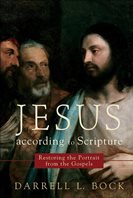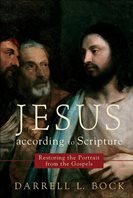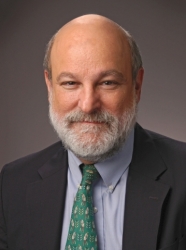Darrell Bock (Executive Director of Cultural Engagement and Senior Research Professor of New Testament Studies at Dallas Theological Seminary) is no stranger to the Gospels, and to all students of the Gospels his name is a familiar one. His widely-recognized work on the Gospel of Luke has been extensive, with three separate commentaries (see here, here, and here), a Theology of Luke-Acts, and various works on the historical Jesus (see here and here and here) all to his credit.
In his Jesus According to Scripture: Restoring the Portrait from the Gospels he very naturally turns his attention to the full-orbed portrait of Jesus provided in the four Gospels collectively and in their distinctive presentations of him. It is a comprehensive, remarkably well-informed, unusually helpful resource for the preacher and for anyone working through the Gospels. Today he is here to talk with us briefly about his work.
Books At a Glance (Fred Zaspel):
Would you characterize for us the literary genre, “Gospel”? How is this significant? What does it tell us about what Matthew, Mark, Luke, and John have to say?
Bock:
It is ancient biography that treats actions and sayings of Jesus as a way to show what God was doing through him. The significance is that it tells us to focus on the relationship between what Jesus says and does. We often treat these as distinct categories, but they are related. The good news is seen is who Jesus is and how he seeks to relate to us. The four gospels tell us this story from four distinct, complementary angles.

Books At a Glance:
What contribution(s) are you hoping to make in Jesus According to Scripture?
Bock:
I wanted to show how the four gospels both complement and are distinct from each other. Most people simply lump them all together. They fail to see why we have four gospel and how each of them works, alongside how they work together. Appreciating the combination of features is important.
Books At a Glance:
How is your presentation of the life of Christ in the Synoptics unique?
Bock:
We work carefully through a synopsis and examine each event in its gospel context. So if there is a distinct placement in one gospel versus another, we take a fresh look at the event from that additional angle. We also seek to summarize the major points of a passage as succinctly as possible. Finally, we summarize the themes of the whole in a final concluding section. In a second edition I am contemplating, this final section will becomes its own book.
Books At a Glance:
Early on you state that your “basic contention is that the coherence of this portrait [of Jesus in the Gospels] emerges and commends itself as one that gives unique insight into who Jesus is and was.” Can you describe that portrait for us briefly?
Bock:
That is the burden of the final section of the book. It shows how the issue of Jesus’ authority and his role in executing salvation are at the core of the gospel accounts. One can really see this in the controversies Jesus has and the miracles he performs. Jesus points to who he is by what he does. He shows more than talks about who he is.
Books At a Glance:
What major themes contribute to this portrait?
Bock:
Beyond the titles tied to Jesus is the significance of what he does. He forgives, sin, rules over the Sabbath, walks over the water, controls the creation, judges what is right, and cleanses the holy space of the temple. This is but a sample of what touches on his authority.
Books At a Glance:
You mention a concern that Christians often may not read the Gospels with a sufficient appreciation of the significance of the events, conversations, and teachings they record. Could you give us a sample that illustrates this concern? What, for example, might we have overlooked concerning Jesus’ calling of the 12 disciples?
Bock:
The selection of the twelve points to a reconfiguring of Israel and a new community of the people of God. It points to a fresh work God is undertaking even as he remains committed to keeping old promises.
Books At a Glance:
Besides matters such as chronology, geography, and general content observations such as these, in what ways do the Synoptics present a common portrait of Jesus? Are there major themes that they share?
Bock:
You will have to see the final section of the book. It traces these much more powerfully than a short answer can do.
Books At a Glance:
In what ways are the four Synoptics distinct from each other?
Bock:
The major thing to see is that Matthew, Mark and Luke tell Jesus’ story from the earth up. It shows how it dawns on people who Jesus is. It starts with categories we are used to and works its way up to presenting fully who Jesus is. John tells the story from heaven down. From John 1:1 you know everything Jesus is. What is fascinating is that three of the accounts work from earth up. We in the church like the story from heaven down, but all of us come to Jesus with an earth up realization of someone showing or telling us how unique Jesus is. Maybe God knew what he was doing when he left this emphasis in the gospels. Maybe the church needs to relearn how to tell the story from the earth up.
Books At a Glance:
How are the Synoptics and John mutually complementary?
Bock:
They all end by emphasizing how Jesus is the unique revelator of God. This is why John 1 calls him the Word and why the Synoptics shows us that the way to understand and find God is to pay careful attention to what God has done through Jesus.
Buy the books

JESUS ACCORDING TO SCRIPTURE: RESTORING THE PORTRAIT FROM THE GOSPELS
